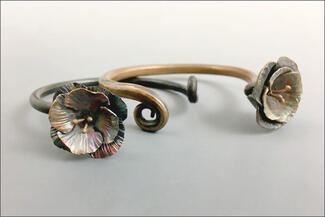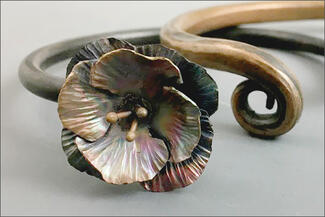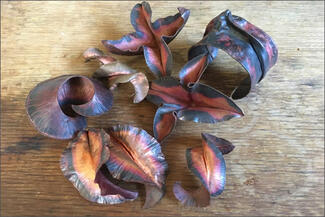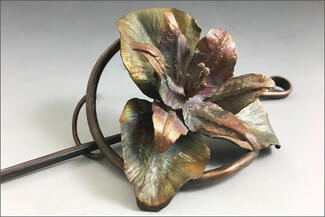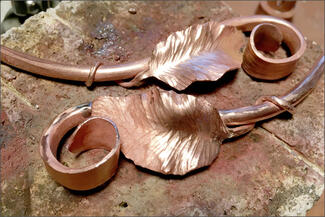Forging Techniques for Jewelry
Forging is the process of moving and manipulating the shape of metals through heating, hammering, pressing, and rolling. In this live, virtual workshop students will learn the fundamentals of moving metal using multiple hammer forging techniques aimed at creating jewelry. Skills and demonstrations will focus on how to taper and spread thick wire stock into various shapes, how to "scroll" wire using both pliers and hammer methods, as well as basic fold-forming techniques for creating unique leaf, conch, and spiral shapes. Additional demonstrations will teach students how to create simple textured flower forms that are sawn, formed, and soldered.
This course is designed to lay the ground work of core forging principles with intent to further student's understanding of how metal moves, when and how to anneal, hammer blow accuracy, and 3-dimentional forms. Copper is highly recommended for practice and budget, but students may also work in fine, sterling, and Argentium silver.
Class will be held live via Zoom during the designated time frame. A link to the Zoom room will be sent via email.
Each session will be recorded and you will receive a password protected link to the recordings that expires after 30 days.
Please read the Materials & Tools tab!
Meet the instructor
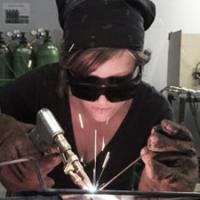
Deanna Pastel was born and raised in Cleveland, Ohio. In 2010 she received her BFA in Jewelry/Metals from Kent State University. Upon graduating, she was offered a position as a bench jeweler and trainer at Heather B. Moore Inc. in Cleveland, OH. This is where she began fine-tuning her skills in soldering gold, setting stones and hand stamping on silver and high end gold jewelry works.
In 2012 she landed in Austin, TX, and began her career as one of the main teachers and as the studio director/coordinator at Creative Side Jewelry Academy. She spent 2012-2017 developing the school’s core curriculum, while working closely with other master artists and her students.
In 2018 she was granted an apprenticeship to spend two months working alongside artist Victoria Lansford doing macro chasing and repousse, and became a presence both artistically and professionally for the Society of North American Goldsmiths. For the past three years, she has expanded to teaching at multiple schools and colleges around the Austin and San Antonio area providing eclectic and diverse course offerings at all levels of experience. She also continues to work at her bench in her home studio doing commissions, custom and repair work, as well as her personal artworks.
Materials & Tools
The following supplies will be used for course demonstrations and objectives. A suggested item and/or vendor has been provided below for reference. Click the vendor name (in red) to be redirected to a page where you can find the item. The quantities needed for each item are listed first. If ordering, please be aware that some items may come in larger quantities than needed for this class. We recommend not opening an item's packaging until the day of the workshop. Student participation during or in-between class sessions is strongly encouraged but not required - observers are welcome.
Metal/raw materials (copper is recommended for practice and you are welcome to get multiple gauges):
- 24" x 6g round wire - copper recommended (Home Depot)
- 6"x6" or more x 24g copper sheet (Rio Grande)
- 6" x 20g round wire - copper, silver, or brass (Rio Grande)
A soldering setup:
- 1 x fireproof area - steel sheet or tile - 12"x12" min. (Amazon or Home Depot)
- 1 x fire bricks (Rio Grande)
- 1 x torch - Silversmith or large MAP gas (Rio Grande or Home Depot)
- 1 x #1 torch tip - if getting Silversmith (Rio Grande)
- 1 x soldering tweezers (Rio Grande)
- 1 x soldering pick (Rio Grande)
- 1 x paste flux (Rio Grande)
- 1 x copper tongs - for pickle (Rio Grande)
- silver solder - hard and medium - a few inches (Rio Grande)
- pickle - for non-ferrous metals (Rio Grande)
- crock pot or tempered glass container with lid - for pickle (Amazon)
- quench bowl or sink - for quenching and rinsing up to 6"
- small brush - for flux
Hand tools:
- 1 x forging hammer (Rio Grande)
- 1 x domed cross peen hammer (Rio Grande)
- 1 x rawhide or plastic mallet (Rio Grande)
- 1 x steel surface (Rio Grande or Harbor Freight or Harbor Freight)
- 1 x bench pin (Rio Grande)
- 1 x jewelers saw (Rio Grande)
- 1 x pack #2/0 saw blades (Rio Grande)
- 1 x needle and round nose pliers (Rio Grande and Rio Grande)
- 1 x aviation snips (Harbor Freight)
- 1 x butter knife or bench knife (Rio Grande)
- 1 x snips (Rio Grande)
- 1 x circle template (Rio Grande)
- 1 x dapping set - wood or metal (Rio Grande)
- 1 x hand file (Rio Grande)
- 1 x center punch (Rio Grande)
- 1 x brass brush (Rio Grande)
- 1 x rotary tool - flex shaft, dremel, hand drill, etc. (Rio Grande)
- 1 x pack drill bits - #52 (Rio Grande)
Other/miscellaneous items:
- 1 x particulate dust mask
- 1 x eye protection
- sand paper strips - 350 to 600 grits (Amazon)
- old tooth brush
- shop rags/towels
- Sharpie marker(s)
- ruler

